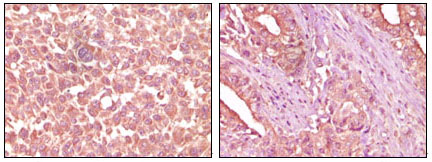EphA2 Monoclonal Antibody
- Catalog No.:YM0222
- Applications:WB;IHC;IF;ELISA
- Reactivity:Human
- Target:
- EphA2
- Fields:
- >>MAPK signaling pathway;>>Ras signaling pathway;>>Rap1 signaling pathway;>>PI3K-Akt signaling pathway;>>Axon guidance
- Gene Name:
- EPHA2
- Protein Name:
- Ephrin type-A receptor 2
- Human Gene Id:
- 1969
- Human Swiss Prot No:
- P29317
- Mouse Swiss Prot No:
- Q03145
- Immunogen:
- Purified recombinant fragment of EphA2 expressed in E. Coli.
- Specificity:
- EphA2 Monoclonal Antibody detects endogenous levels of EphA2 protein.
- Formulation:
- Liquid in PBS containing 50% glycerol, 0.5% BSA and 0.02% sodium azide.
- Source:
- Monoclonal, Mouse
- Dilution:
- WB 1:500 - 1:2000. IHC 1:200 - 1:1000. ELISA: 1:10000.. IF 1:50-200
- Purification:
- Affinity purification
- Storage Stability:
- -15°C to -25°C/1 year(Do not lower than -25°C)
- Other Name:
- EPHA2;ECK;Ephrin type-A receptor 2;Epithelial cell kinase;Tyrosine-protein kinase receptor ECK
- Molecular Weight(Da):
- 108kD
- References:
- 1. Shaji Abraham, Deborah W. Knapp, Liang Cheng. Clin Cancer Res. 2006 Jan 15;12(2):353-60.
2. Charles N Landen, Michael S Kinch, Anil K Sood. Expert Opin Ther Targets. 2005 Dec;9(6):1179-87.
- Background:
- This gene belongs to the ephrin receptor subfamily of the protein-tyrosine kinase family. EPH and EPH-related receptors have been implicated in mediating developmental events, particularly in the nervous system. Receptors in the EPH subfamily typically have a single kinase domain and an extracellular region containing a Cys-rich domain and 2 fibronectin type III repeats. The ephrin receptors are divided into 2 groups based on the similarity of their extracellular domain sequences and their affinities for binding ephrin-A and ephrin-B ligands. This gene encodes a protein that binds ephrin-A ligands. Mutations in this gene are the cause of certain genetically-related cataract disorders.[provided by RefSeq, May 2010],
- Function:
- catalytic activity:ATP + a [protein]-L-tyrosine = ADP + a [protein]-L-tyrosine phosphate.,function:Receptor for members of the ephrin-A family. Binds to ephrin-A1, -A3, -A4 and -A5.,similarity:Belongs to the protein kinase superfamily. Tyr protein kinase family. Ephrin receptor subfamily.,similarity:Contains 1 protein kinase domain.,similarity:Contains 1 SAM (sterile alpha motif) domain.,similarity:Contains 2 fibronectin type-III domains.,subunit:Interacts with SLA (By similarity). Interacts with INPPL1/SHIP2.,tissue specificity:Expressed most highly in tissues that contain a high proportion of epithelial cells, e.g., skin, intestine, lung, and ovary.,
- Subcellular Location:
- Cell membrane ; Single-pass type I membrane protein . Cell projection, ruffle membrane ; Single-pass type I membrane protein . Cell projection, lamellipodium membrane ; Single-pass type I membrane protein . Cell junction, focal adhesion . Present at regions of cell-cell contacts but also at the leading edge of migrating cells (PubMed:19573808, PubMed:20861311). Relocates from the plasma membrane to the cytoplasmic and perinuclear regions in cancer cells (PubMed:18794797). .
- Expression:
- Expressed in brain and glioma tissue and glioma cell lines (at protein level). Expressed most highly in tissues that contain a high proportion of epithelial cells, e.g. skin, intestine, lung, and ovary.
- June 19-2018
- WESTERN IMMUNOBLOTTING PROTOCOL
- June 19-2018
- IMMUNOHISTOCHEMISTRY-PARAFFIN PROTOCOL
- June 19-2018
- IMMUNOFLUORESCENCE PROTOCOL
- September 08-2020
- FLOW-CYTOMEYRT-PROTOCOL
- May 20-2022
- Cell-Based ELISA│解您多样本WB检测之困扰
- July 13-2018
- CELL-BASED-ELISA-PROTOCOL-FOR-ACETYL-PROTEIN
- July 13-2018
- CELL-BASED-ELISA-PROTOCOL-FOR-PHOSPHO-PROTEIN
- July 13-2018
- Antibody-FAQs
- Products Images

- Western Blot analysis using EphA2 Monoclonal Antibody against NIH/3T3 cell lysate.

- Immunohistochemistry analysis of paraffin-embedded human skin carcinoma (left) and pancreas carcinoma (right) tissue, showing cytoplasmic localization with DAB staining using EphA2 Monoclonal Antibody.



